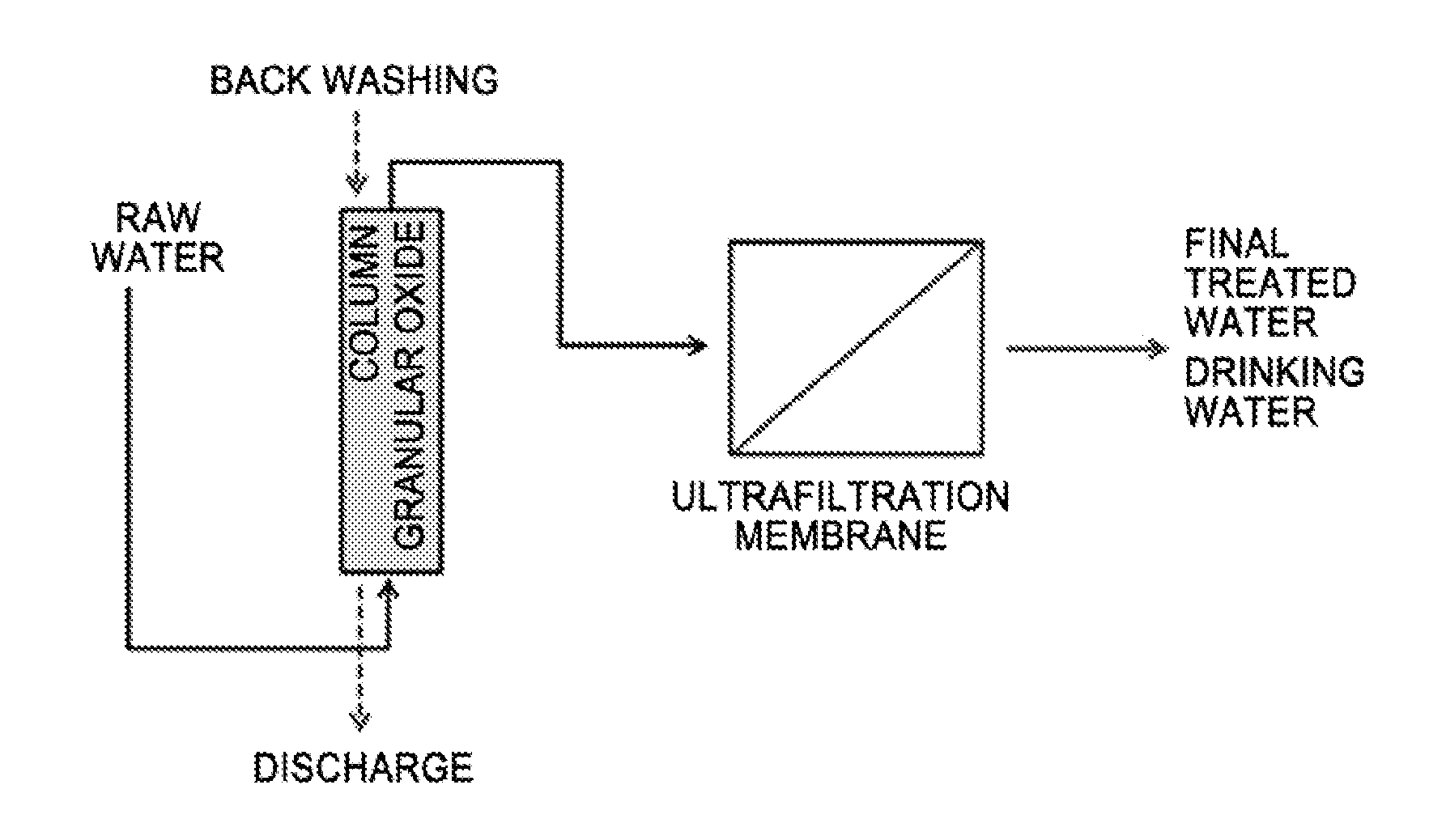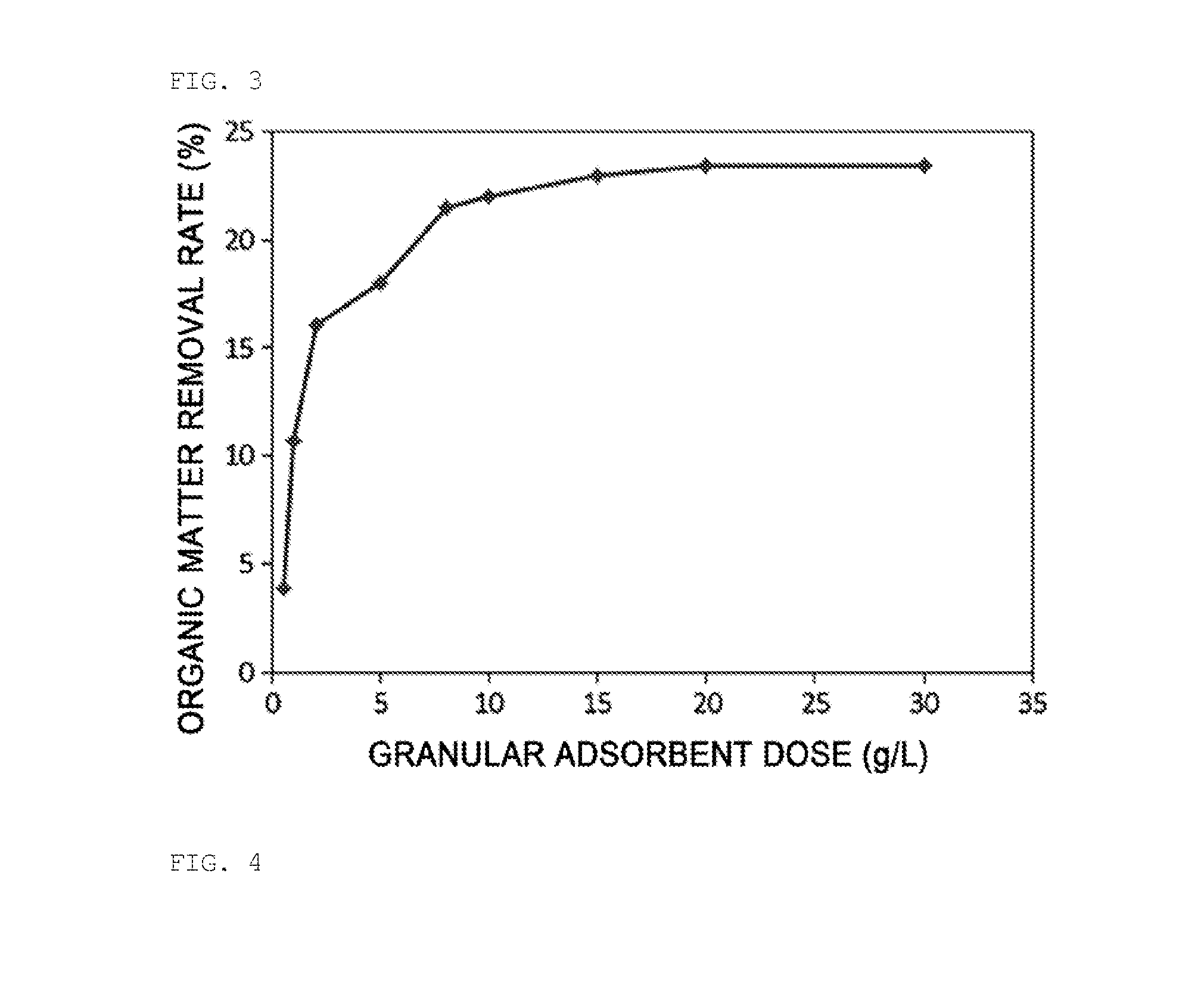Preparation method of granular oxide adsorbent, and water treatment method using same
a technology of granular oxide and adsorbent, which is applied in the direction of other chemical processes, membranes, separation processes, etc., can solve the problems of deteriorating facilities, poor water quality of raw water, and deteriorating circumstances of small-scale water supply facilities, so as to improve water treatment efficiency and high regeneration
- Summary
- Abstract
- Description
- Claims
- Application Information
AI Technical Summary
Benefits of technology
Problems solved by technology
Method used
Image
Examples
example 2
Preparation of Ferrihydrite Granular Oxide Adsorbent
[0044]An aqueous ferrihydrite solution was prepared by introducing FeCl3 to distilled water and adjusting the final concentration to 10 g Fe / L, the polymer particles of Example 1 were immersed therein, and were agitated for approximately 12 hours. The pH was adjusted to pH 7 by adding an aqueous sodium hydroxide solution to the mixture. The mixture was agitated for approximately 48 hours so that the oxide was favorably formed in the polymer particles. The mixture was dried by being placed for 48 hours at room temperature. A ferrihydrite granular adsorbent was prepared by washing the dried mixture with ultrapure water several times for additional purification, and drying in a vacuum oven for approximately 48 hours at room temperature.
example 3
Preparation of Magnetite Granular Oxide Adsorbent
[0045]An aqueous magnetite solution was prepared by introducing FeSO4 to distilled water and adjusting the final concentration to 10 o Fe / L, the polymer particles of Example 1 were immersed therein, and were agitated for approximately 12 hours. The pH was adjusted to pH 11 by adding an aqueous sodium hydroxide solution to the mixture. The mixture was agitated for approximately 48 hours so that the oxide was favorably formed in the polymer particles. The mixture was dried by being placed for 48 hours at room temperature. A magnetite granular adsorbent was prepared by washing the dried mixture with ultrapure water several times for additional purification, and drying in a vacuum oven for approximately 48 hours at room temperature.
experimental example
[0046]1) Properties of Raw Water
[0047]For performance tests of the granular oxide adsorbents prepared in Example 2 and Example 3, influent raw water of Duryu Water Treatment Plant in Daegu, Korea, was used as feed water. The raw water was stored at 4° C. before use. The raw water was equilibrated for 2 hours at room temperature before the tests began. Then the raw water was treated with a 200 μm filter (Melt-Blown Bonded Cartridge Filter Pore-Cell Micro filter EP8P-LTC, Clean & Science, Korea) in order to remove turbidity and large particles, and used as the feed water. Specific qualities of the raw water are shown in Table 1.
TABLE 1ItemValuepH7.23Turbidity, NTU0.297Total Organic Carbon, mg / L2.05UV254, cm−10.036SUVA, L / mg-m1.76Electrical Conductivity, μs / cm278Aluminum, mg / L0.056Calcium, mg / L27.06
[0048]2) Operating Condition of Membrane and Membrane Filtration System
[0049]An ultrafiltration membrane made of polyvinylidene fluoride (PVDF) having a pore size of approximately 40 nm was ...
PUM
| Property | Measurement | Unit |
|---|---|---|
| pH | aaaaa | aaaaa |
| pH | aaaaa | aaaaa |
| pH | aaaaa | aaaaa |
Abstract
Description
Claims
Application Information
 Login to View More
Login to View More - R&D
- Intellectual Property
- Life Sciences
- Materials
- Tech Scout
- Unparalleled Data Quality
- Higher Quality Content
- 60% Fewer Hallucinations
Browse by: Latest US Patents, China's latest patents, Technical Efficacy Thesaurus, Application Domain, Technology Topic, Popular Technical Reports.
© 2025 PatSnap. All rights reserved.Legal|Privacy policy|Modern Slavery Act Transparency Statement|Sitemap|About US| Contact US: help@patsnap.com



